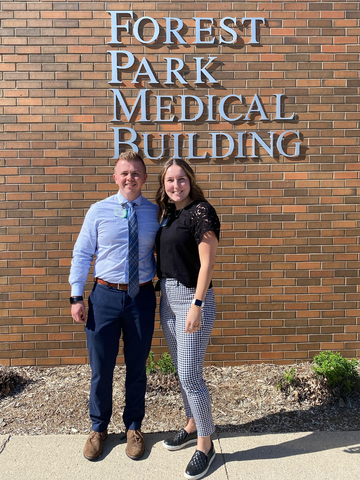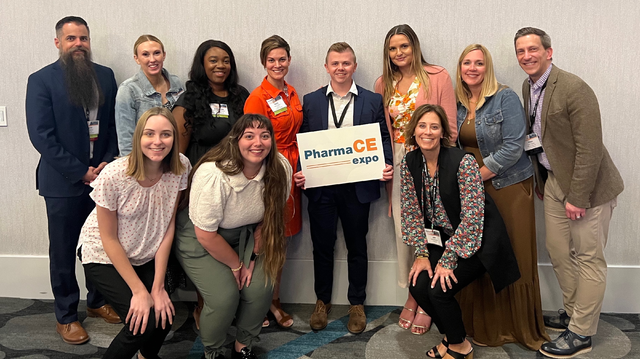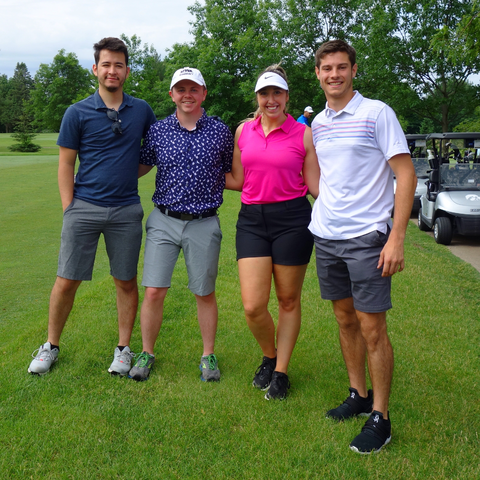After spending the past seven years of my life in “student mode” – going to class, studying, doing homework, and working part-time when I could fit it in my schedule – one of my biggest concerns heading into my year of rotations was how drastically different my daily routines were going to be since I would practically be working a fulltime job in my final year as a pharmacy student. Now that I have a few weeks of rotations under my belt, I can say that I was NOT prepared for such a drastic switch in my daily lifestyle. This first cycle has been eye-opening for me in more ways than one, and I definitely wish I would have had an opportunity to mentally prepare for this change. So, that’s what I’m hoping to accomplish for others with this month’s blog topic: The Day in the Life of a P4.
But before I get into that, a little bit more about me:
Growing up in a small town in northern Iowa certainly had its blessings – tightknit community, friendly neighborhoods, and a safe environment for me and my rambunctious brothers to ride our bikes, climb trees and skin our knees just enough times to always keep our parents on the edge of their seats. While I am grateful for my small-town upbringing, the opportunities and experiences that I personally wanted to manifest for my life were much harder to come by in this type of setting. With that in mind, I knew my time in Belmond would be pretty limited after I had graduated high school.
With a consistently hectic schedule during my four years of undergrad studies and first three years of pharmacy school, it has been a challenge for me to spend a significant amount of time back home outside of most major holidays and family get-togethers. During the past seven years of being away from Belmond, lots of things have changed – many of my hometown friends have moved away and started their own families, and/or are thriving within their own respective careers. But in despite of all these things, whenever I do get a few days to return it always still feels like home.
So, imagine my surprise when I found out that my first five-week rotation would take me back to the place where my pharmacy journey all began – living in my childhood home in Belmond.
Even better, my Cycle 1 rotational site is at MercyOne North Iowa Medical Center in Mason City, which is TRULY where it all began for me… since I was born there.
My preceptor at MercyOne, Dr. John Swegle, has a unique role for a pharmacist as he works within the Family Medicine Residency Program, which is associated with the University of Iowa Carver College of Medicine. As the only pharmacist among physicians and other medical professionals on staff, it is a unique role that truly shows the value of interdisciplinary healthcare collaboration and education. It is also a great opportunity to show student pharmacists like myself that there truly are an unlimited amount of career options available to us after graduation. It also provides an incredible amount of variability throughout the day, and this allows for numerous opportunities for students to get exposed to many different patient populations and disease states.
A typical day of rotations for me at MercyOne Forest Park Family Medicine:
 6:15 AM to 7:00 AM — Drive from Belmond to Mason City
6:15 AM to 7:00 AM — Drive from Belmond to Mason City
I wanted to include my commute time for a few different reasons. First, this is by far the longest commute I have ever had going to a job or school, and initially, I was nervous about it. I knew commutes were common, but I have never had to experience anything more than a 15-minute drive to work. After getting a few days of making the drive under my belt, I actually found myself enjoying the time. I have enjoyed listening to audiobooks and podcasts that I normally wouldn’t have time for, and I enjoy the time alone to drink my morning coffee and mentally prepare for the day. It was also important to me that I point out that while it is typical to spend eight to nine hours a day at a rotational site, it’s not unheard of to commit ten or more hours of the day away from home while on rotations.
7:00 AM to 8:00 AM — Prepare for In-Patient Rounds
The majority of our mornings are dedicated to working up and checking in on hospitalized patients. While official rounds start around 8 AM, it’s important for us to look up our patients’ health information and have a firm grasp on their situation and how they are progressing. As the “drug people” (as my preceptor likes to say), it is also important for us to check patients’ medication lists and see if there is anything that may be missing from their treatment regimen or exacerbating their issues. This is also a good time for us to read up on disease states and brainstorm medication-related treatment options to give recommendations. When we’re at our workstations, I like to utilize drug information resources such as Lexicomp and UpToDate to reference current guidelines and dosing information for my recommendations.
8:00 AM to 9:30 AM — In-Patient Discussion
After working up our patients, we then head off to have formal discussions with our rounding team, which typically consists of three to four resident physicians and an attending physician. During this time, we discuss every patient under our care individually and offer advice or recommendations based on how the patient is presenting that morning. This may include fluid resuscitation, medication dose changes, pain management techniques, or any other medication-related issue a patient may be dealing with at that moment. Since there is no telling what the physicians may ask for our help with, my preceptor strongly recommended for us use our phones to help find resources. I like to the UpToDate Mobile App on my phone to help guide my decision-making.
*While my preceptor prefers that we use our phones to access these resources, it is always critical to have this conversation with them early on – every site is different and will have different policies in place regarding the use of cellphones during rotations.
9:30 AM to 11:00 AM — In-Patient Rounding and Debrief
After completing our initial discussions on each patient, we go up to the hospital and start our rounds. During this, we visit each patient as a team and discuss our plan and options with them to allow for a shared decision-making process. This is also an opportunity for the patient to directly ask the physicians or us any questions that they may have about their ailments.
After visiting with each patient, we then head back to have our final discussion of the morning. During this debrief, we reaffirm that we’re all on the same page when it comes to treatment decisions and timelines for discharging the patient from the hospital.
11:00 AM to 12:00 PM — Post-Rounding Pharmacy Discussion
After returning from rounding, my preceptor sits down with us students to answer any questions that may have come up during the morning. This is a great time for us to apply information that we received in pharmacy school classes to real-life patient cases. It is also a great opportunity for us to see how real-life practice of healthcare can differ from what we may have learned in the classroom. While guidelines and tables are nice references, healthcare is extraordinarily personalized to each individual patient. This leads to a lot of “gray areas” in practice, and that’s where a combination of evidence-based practice, shared decision making, and clinical experience comes into play.
12:00 PM to 1:00 PM — Noon Conference and Lunch
After a busy morning, it’s time for lunch. On most days during the noon hour, the Family Medicine Program also provides an hour of educational presentations on a wide variety of topics. While these are designed for the physician residents, there’s almost always something valuable for us to take away from these sessions. Examples have included financial planning, contract negotiation techniques, geriatric case studies, and we even got to play Jeopardy with them!
On days that there aren’t presentations scheduled, I like to use this time to listen to CEimpact’s GameChangers Pharmacotherapy or Level Up podcast to stay up to date on all things pharmacy! This gets me 30 minutes of pharmacotherapy updates every week Since the episodes are timed with news or the latest updates, this podcast really helps me feel prepared for questions and discussions that come up in conversations with my preceptor.
1:00 PM to 2:30 PM — Topic Discussion/Journal Clubs
After lunch, we head back for our daily topic discussions with our preceptor. Most days, we students get to select a disease state that we want to discuss and learn/re-learn more about. We then take turns leading a lecture-discussion on the topic including background information and treatment options. Recently we have discussed topics such as fluid replacement, strokes, heart failure and COPD management. These topic discussions have been invaluable to me, as they serve as excellent reviews and will help me as I begin preparing for the NAPLEX.
On days that we don’t have topic discussions, we have done Journal Clubs, with each of the students leading the presentations individually. These can be pretty intimidating, especially during the few first rotations of the P4 year, but thanks to CEimpact’s monthly Journal Club, I felt confident and prepared to lead a discussion.
{{cta(‘f2202eb7-603e-4f66-9977-0fbc7277d904′,’justifyright’)}}
2:30 PM to 4:30 PM — Outpatient Clinic
After wrapping up discussions for the day, we head up to the clinic to finish the day. During this time, we join the attending physicians and listen to the resident physicians present patients that they are seeing in the clinic. Since this is a Family Medicine Clinic, there is no telling what situations they may be dealing with throughout the afternoon. We serve as resources for the residents to help them decide if patients are appropriate for medication therapy, and how to properly dose and titrate medications. Some of the more common questions we get include anticoagulation dose changes, blood pressure management and migraine therapy options. This is also a good time for us to read new research articles and review guidelines on any new topics that we may need to brush up on.
4:30 PM to 5:15 PM — Drive Home
Again, I wanted to include my commute back home because I have come to find that it is one of the most important parts of my day. The truth is that some days on rotation can be long and demanding and having healthy ways of dealing with the stress and rigors of a long day can be an incredibly effective tool in preventing burnout and avoiding feeling overwhelmed. For me, my drive back home after those long days is a chance for me to clear my head, listen to music and relax to separate my workday from my home life. I also utilize exercise as a healthy outlet for my stress, so I also use this time to mentally prepare to go to the gym to work out after I return back home. Knowing what works best for you in these situations is crucial to making the most out of your rotational experiences.
—

It’s hard for me to put into words how grateful I am to have started my year on rotations the way I have. I will be the first to admit that I was not entirely excited to move back home and commute 45 minutes every day to a hospital for five weeks. But as I get ready to wrap up this experience and move on, I can honestly say that I am thankful. While I had to go through a major personal headspace shift at the beginning of the rotation, my preceptor has always been understanding and willing to help. As a past president of the Iowa Pharmacy Association, my preceptor has even allowed me to attend this year’s PharmaCE Expo and the IPA Eggleston-Granberg Golf Classic in lieu of attending clinicals those days. These events have also helped me stay connected and recharged throughout the rotation. Spending time with my family throughout this first cycle has also been a blessing. Having their constant support and encouragement has been incredibly valuable in keeping me motivated and driven at the beginning of this adventure.
 As I get my first taste of this year-long adventure throughout rotations, I can confidently say that it is a whole different animal than the first three years of pharmacy school. While sometimes the days may feel long, the weeks are always quick.
As I get my first taste of this year-long adventure throughout rotations, I can confidently say that it is a whole different animal than the first three years of pharmacy school. While sometimes the days may feel long, the weeks are always quick.
With fate bringing me back to where it all began, I can’t wait to see what it has in store next.
{{cta(‘1999f129-41c8-4ca7-84ce-12ef94bb5846′,’justifycenter’)}}

